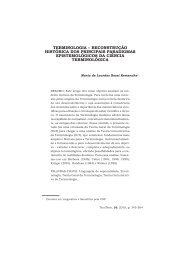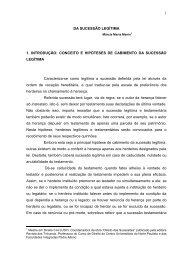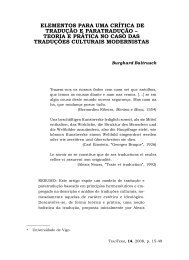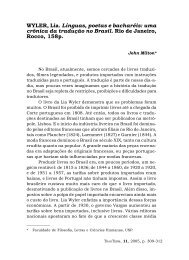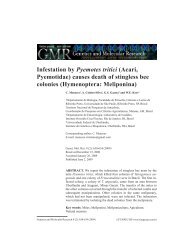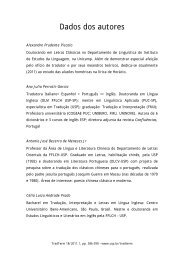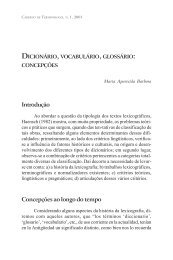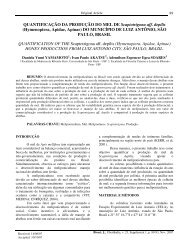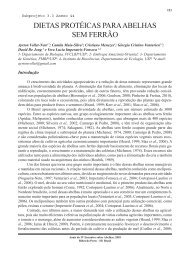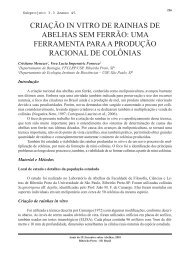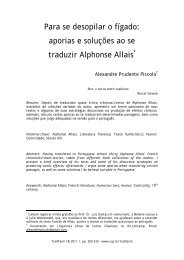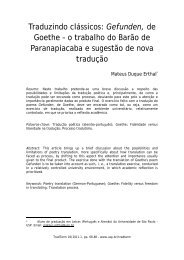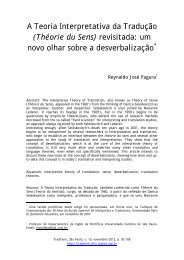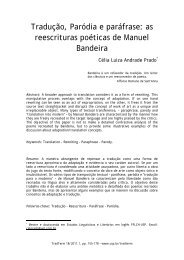Bees as pollinators in Brazil - USP
Bees as pollinators in Brazil - USP
Bees as pollinators in Brazil - USP
You also want an ePaper? Increase the reach of your titles
YUMPU automatically turns print PDFs into web optimized ePapers that Google loves.
30<br />
Observations: Species identification should be made by tra<strong>in</strong>ed people, with the aid of taxonomic<br />
keys and reference collections. Those responsible for identifications should be contacted <strong>in</strong><br />
advance. Manuals should <strong>in</strong>clude <strong>in</strong>formation on national collection and taxonomy services.<br />
F<strong>in</strong>al Remarks<br />
It w<strong>as</strong> obvious that no fixed protocol could be<br />
provided for all situations. Moreover, different<br />
people had different experiences with different<br />
sampl<strong>in</strong>g methods. S<strong>in</strong>ce no comparative<br />
data exist on those methodologies, no consensus<br />
w<strong>as</strong> reached on which methods to recommend<br />
for given situations. Thus, such comparative<br />
data should be sought for before any<br />
def<strong>in</strong>itive recommendations can be built <strong>in</strong> the<br />
context of the <strong>Brazil</strong>ian Poll<strong>in</strong>ator Initiative.<br />
C<strong>as</strong>e Studies – an exercise<br />
Aim<br />
To provide examples of how the above recommendations<br />
could be used <strong>in</strong> the development<br />
of survey and monitor<strong>in</strong>g protocols.<br />
The group w<strong>as</strong> divided <strong>in</strong>to three subgroups,<br />
each of which worked on one c<strong>as</strong>e<br />
study. The result<strong>in</strong>g protocols presented below<br />
were constructed b<strong>as</strong>ed upon literature <strong>in</strong>formation<br />
and the expertise of group members,<br />
with surveys and monitor<strong>in</strong>g of bees on specific<br />
crops and <strong>in</strong> different k<strong>in</strong>ds of environments<br />
taken <strong>as</strong> examples.<br />
1) MONITORING FLOWER-VISITING BEES<br />
IN COTTON FIELDS<br />
Background<br />
Accord<strong>in</strong>g to Barroso & Freire (2003), three<br />
species of cotton are found <strong>in</strong> <strong>Brazil</strong>,<br />
Gossypium hirsutum (L.), G. barbadense (L.)<br />
and G. mustel<strong>in</strong>um (Mier). Of these, only<br />
herbaceous cultivars of the <strong>in</strong>troduced G. hirsutum<br />
are currently cultivated on a commercial<br />
scale <strong>in</strong> <strong>Brazil</strong>. However, cultivation systems are<br />
not homogeneous across the large cotton-produc<strong>in</strong>g<br />
regions of <strong>Brazil</strong>. An evident contr<strong>as</strong>t<br />
exists, for example, between the small-scale<br />
production found <strong>in</strong> the small family-held<br />
farms <strong>in</strong> the northe<strong>as</strong>tern region of <strong>Brazil</strong>,<br />
which employ a low technology crop system,<br />
and the large scale production system<br />
employed <strong>in</strong> the huge commercial farms <strong>in</strong><br />
central <strong>Brazil</strong>.<br />
The cotton plant can produce nectar <strong>in</strong><br />
five different k<strong>in</strong>ds of nectaries distributed<br />
<strong>in</strong>side and outside the flower. However, not all<br />
of these nectaries occur <strong>in</strong> every cultivar (Free,<br />
1970; McGregor, 1976). Many different<br />
organisms are attracted to the cotton flower<br />
by the nectar and pollen it produces. Among<br />
these, <strong>in</strong>sects and especially bees are the most<br />
abundant. These flower-visit<strong>in</strong>g species may<br />
contribute to <strong>in</strong>cre<strong>as</strong>es <strong>in</strong> fiber production<br />
and/or quality (Free, 1970; McGregor, 1976).<br />
The suggestions below were constructed<br />
consider<strong>in</strong>g a small-scale system. Considerations<br />
on how to expand this protocol to a largescale,<br />
high-technology system are presented at<br />
the end of this exercise.<br />
Survey<br />
The survey of cotton-flower visit<strong>in</strong>g species is<br />
proposed for 1 ha fields, considered here <strong>as</strong><br />
sampl<strong>in</strong>g units. This is an average size field for<br />
cotton <strong>in</strong> Northe<strong>as</strong>tern <strong>Brazil</strong>. In each such<br />
sampl<strong>in</strong>g unit, two sampl<strong>in</strong>g procedures<br />
would be executed <strong>in</strong> parallel:<br />
A) Arbitrary sampl<strong>in</strong>g. This protocol<br />
aims to maximize the number of flower visit-



